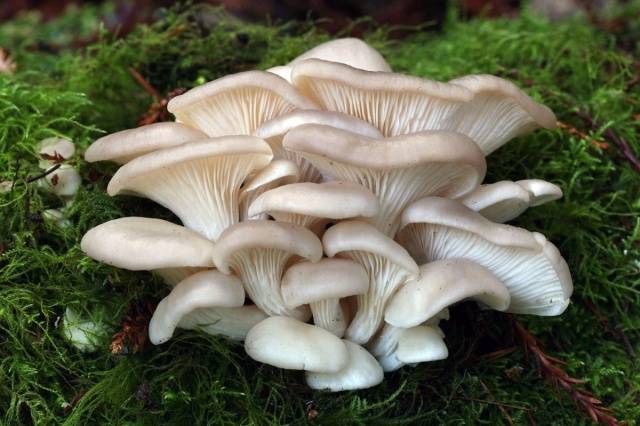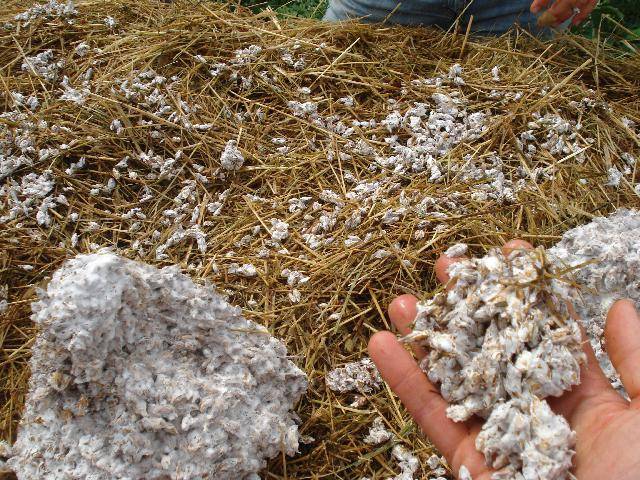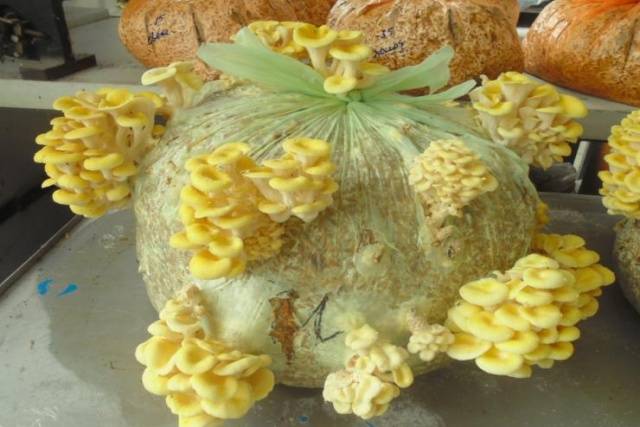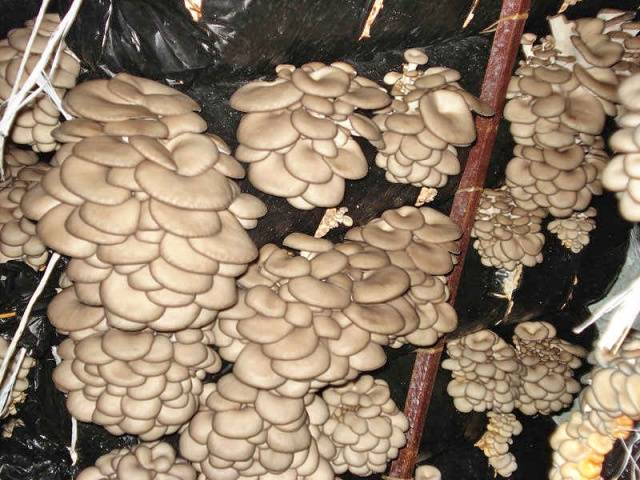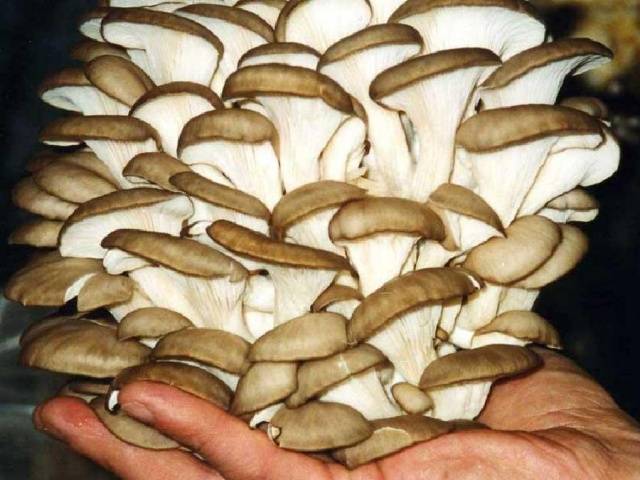Content
Oyster mushrooms in bags are grown at home if the necessary conditions are provided. The required temperature and humidity levels are maintained in the room. With proper preparation, you can get a good harvest in a few months.
Features of oyster mushrooms
Oyster mushrooms are mushrooms that grow in temperate and tropical climates of Europe and Asia. They can be found on dead wood as gray or white clusters. The cap dimensions are 5-25 cm. The main advantage of these mushrooms is their unpretentiousness to external conditions: they germinate on any cellulose material.
Oyster mushrooms contain various beneficial substances. One of them is lovastine, which helps lower blood cholesterol. With their regular use, the body's immune properties increase and the risk of developing atherosclerosis decreases.
Oyster mushrooms are rich in vitamin C and group B. In terms of phosphorus, iron and calcium content, these mushrooms are superior to beef and pork.Their calorie content is 33 kcal, which allows them to be used to combat excess weight.
If consumed in excess, mushrooms cause harm to the body. Therefore, it is recommended to include them in the diet in small portions. In this case, the mushrooms must be subjected to heat treatment to eliminate toxic substances.
You can grow oyster mushrooms for your own consumption or for sale. Their unpretentiousness and high nutritional quality make these mushrooms a popular source of income.
Preparation for cultivation
Before you start growing, you need to prepare the room and, if necessary, purchase additional equipment. Be sure to prepare the substrate and mycelium.
Selecting a room
For growing oyster mushrooms in bags, a cellar, basement or hole in the garage is suitable. You must first disinfect the room. To do this, prepare a 4% lime solution, which is used to treat all surfaces. Then the room is closed for a day. After the specified time, it is ventilated until the smell disappears completely.
In its natural environment, oyster mushrooms grow in high humidity. Such places should be well ventilated. At home, mycelium germinates at the following indicators:
- humidity at 70-90%;
- availability of lighting (natural or artificial);
- temperature from +20 to +30 degrees;
- constant supply of fresh air.
Selection of bags
One of the main points when deciding how to grow oyster mushrooms is choosing the appropriate method. At home, bags are used for these purposes.
For these purposes, any plastic bags are used. Their size is selected depending on the size of the crop that needs to be grown and the dimensions of the room.
The bags must be durable, especially if they are hung indoors. How many bags are needed depends on the volume of plantings. The minimum capacity of bags should be 5 kg.
Seed material
Mycelium for producing oyster mushrooms can be purchased at specialized enterprises that grow these mushrooms. In industrial conditions, the period of use of seed material is no more than a year.
Therefore, the mycelium is sold at retail at low prices, although it still retains the ability to bear fruit. For beginners, this is a great opportunity to try their hand at growing oyster mushrooms.
At the initial stage, it is not recommended to purchase too much oyster mushroom mycelium. Before planting, it must be stored in the refrigerator so that it does not spoil. The purchased mycelium is yellow or orange in color.
Immediately before planting, the mycelium is left for a day at room temperature. Then the planting material is carefully crushed after opening the bag and transferred for a short time to the room where it is planned to grow mushrooms. This will allow the mycelium to adapt to changing conditions.
The package is opened in a clean room using gloves. It is recommended to plant and germinate oyster mushrooms in different rooms to avoid mycelium infection.
High-quality oyster mushroom mycelium is obtained in the laboratory, but it can be grown independently. To do this, take the upper part of the fruiting body of the mushroom, which is treated with hydrogen peroxide. A portion of the mushroom is then placed in a test tube placed over a flame. It is first filled with a nutrient mixture.
The containers with oyster mushrooms are closed and placed in a dark room where the temperature is maintained at 24 degrees. After two weeks, the mycelium is ready for planting.
Substrate preparation
To grow oyster mushrooms, you need a substrate, the functions of which are performed by sunflower husks, sawdust, corn cobs, and cereal straw. These mushrooms grow well on sawdust of deciduous wood.
The mixture is preliminarily processed as follows:
- The material is poured with warm water (temperature 25 degrees) for 20 minutes and stirred periodically.
- The water is drained, the mixture is squeezed out, and the container is filled with hot water (temperature 70 degrees). A pressure is placed on top of the material.
- After 5 hours, the water is drained and the substrate is squeezed out.
- To improve the nutritional properties of the material, you need to add mineral components: 0.5% each of urea and superphosphate and 2% of crushed limestone and gypsum.
- The substrate humidity should remain at 75%.
Another way to process the substrate for oyster mushrooms is to boil it. To do this, place it in a metal container, add water and boil for 2 hours.
It is allowed to use a mixture of the specified components. When growing mushrooms on sawdust, the content of other substances is no more than 3% of the total mass of the substrate.
If preparing the substrate yourself causes difficulties, you can purchase it ready-made. The main requirement for materials is the absence of mold. When purchasing, you need to pay attention to its composition. Usually the packaging indicates which mushrooms it can be used for. Ready-made substrates for oyster mushrooms, champignons, honey mushrooms and other mushrooms can vary significantly.
Equipment purchase
To obtain stable yields, you need to equip a room for growing oyster mushrooms. If mushrooms are sold, then purchasing equipment will be an important investment in your future business.
To maintain the temperature, you need to purchase a heater. Cold rooms will require additional thermal insulation. Walls and floors are subject to insulation. You need to control the temperature using a thermometer.
Oyster mushrooms do not like direct sunlight, but to arrange lighting you need to purchase daylight devices. Spraying of plantings is carried out with a conventional spray bottle. To maintain the required microclimate, fog generation units are used.
Supply and exhaust ventilation will help ensure the flow of fresh air. In a small room, a household fan can accomplish this task.
Getting Mushroom Blocks
Oyster mushrooms are grown at home in the form of mushroom blocks resembling beds. Their composition includes a prepared substrate, which is placed in bags in layers.
For every 5 cm of material you need to plant 50 mm of mycelium. In this case, the bottom and top layers should remain the substrate. The materials are laid tightly, but without compaction. The bag should be filled to 2/3 of the total volume.
The bags are tightly tied, after which small holes are made in them through which the mycelium will grow. The size of the holes is no more than 2 cm, and they are placed every 10 cm in a checkerboard pattern or in a random manner.
Then the prepared containers are placed for two weeks in a dark place where a constant temperature is maintained (from +19 to +23 degrees). Bags of oyster mushrooms can be hung or stacked on top of each other in several rows.
During the incubation period, ventilation of the room is not required. The carbon dioxide content increases humidity, which allows the mycelium to develop faster. Within 10 days, active growth of oyster mushrooms occurs, the mycelium becomes white, and a distinct mushroom smell appears.
After 20-25 days, the room with oyster mushrooms is ventilated or moved to another room. In the future, plantings require lighting for 8 hours a day.
Oyster mushroom care
After germination, the mushrooms are provided with the necessary care. The list of actions on how to care for oyster mushrooms includes maintaining temperature and humidity.
Maintaining conditions
Grow oyster mushrooms necessary at a certain temperature. Throughout the entire period, its indicators should remain constant.
The permissible change in temperature is no more than 2 degrees. With significant fluctuations, seedlings may die.
Ambient temperature affects the color of mushroom caps. If its value was about 20 degrees, then oyster mushrooms are distinguished by a light shade. When the temperature rises to 30 degrees, the caps become darker.
When caring for oyster mushrooms, you need to maintain the required level of illumination. If there is no natural light in the room, lighting fixtures are installed. For 1 sq. m need to provide lighting with a power of 5 W.
Every day, the room where oyster mushrooms are grown is cleaned using substances containing chlorine. This will prevent the spread of mold and disease.
Watering
For active growth of mushrooms, it is necessary to maintain optimal humidity levels. This is ensured by an irrigation system. There is no need to water oyster mushrooms in bags during the incubation period.
When the shoots appear, the mycelium will require regular watering. It is watered once or twice a day with warm water.
To maintain humidity at 80-100%, you can place containers of water in the room. The walls and ceiling are also sprayed.
Harvesting
Oyster mushrooms appear next to the holes made in the bag. In order for the mushrooms to accurately enter the holes, they need to be widened. When oyster mushrooms begin to appear in the holes, they can be removed after about a week.
The first harvest is harvested 1.5 months after planting. How to cut oyster mushrooms correctly? They are removed at the base with a sharp knife. It is important not to damage the caps and mycelium.
After the first harvest is harvested, the second wave of mushrooms will appear in 2 weeks. The third time, the mushrooms can be cut after another 2 weeks.
In total, oyster mushrooms are harvested three times. The first wave accounts for 70% of the total harvest, then you can get another 20% and 10%. How much the harvest will be directly depends on the volume of the substrate. Over the entire growing period, you can collect 3 kg of mushrooms from one 10 kg bag.
Storing oyster mushrooms
If oyster mushrooms are not used immediately, then you need to prepare a storage container. Proper storage extends the shelf life of mushrooms and preserves essential nutrients.
Further storage largely depends on the method of processing the mushrooms. It is not recommended to soak oyster mushrooms as they become watery and lose their beneficial properties. After collection, just rinse them with running water.
The best way to store oyster mushrooms is to use the refrigerator. The mushrooms are first wrapped in paper or placed in plastic containers intended for food products. Up to 1 kg of mushrooms can be stored in one container. At a temperature of -2 degrees, the shelf life of mushrooms is 3 weeks. If the temperature rises to +2 degrees, this period will be shortened to 4 days.
Oyster mushrooms can be frozen. Clean mushrooms without deformation or damage are stored for 5 months.
When the temperature drops to -18 degrees, the storage period increases to 12 months. It is not recommended to wash them before freezing; just wipe them with a cloth and cut off the stems. Re-freezing is not allowed.
Conclusion
Oyster mushroom is a healthy mushroom that can be obtained at home. For this, bags are purchased, a substrate and mycelium are prepared. To simplify the process, you can purchase ready-made components, but this will require additional costs. Cultivation includes two stages: the incubation period and the active growth of the mycelium. The harvested crop is sold for sale or used for their own purposes.
